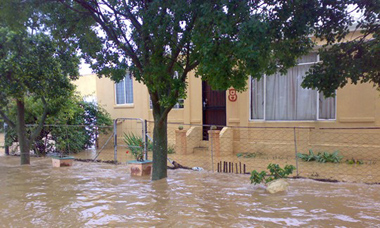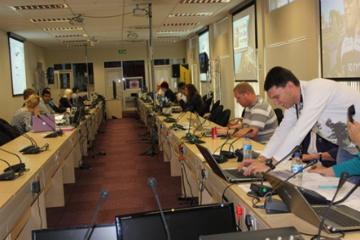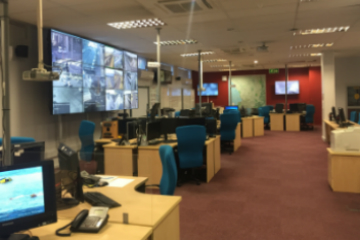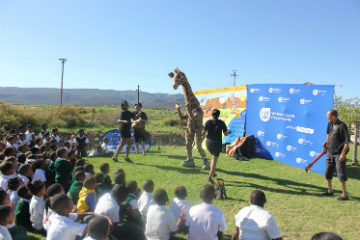Western Cape Disaster Management Centre (WCDMC)
What is a disaster?
A disaster is a progressive or sudden, widespread or localised, natural or human-caused incident that:
(a) causes or threatens to cause
- death, injury or disease,
 damage to property, infrastructure or the environment, or
damage to property, infrastructure or the environment, or- disruption of the life of a community, and
(b) is of a scale that exceeds the ability of those affected by the disaster to cope with the effects using only their own resources.
Role of the Western Cape Disaster Management Centre (WCDMC)
Colin Deiner, the head of Disaster Management in the Western Cape, says the WCDMC provides a single environment where all disaster management activities can be planned for and coordinated in an integrated manner.
Disaster management aims to
- prevent or reduce the risk of disasters,
- mitigate the severity or consequences of disasters,
- ensure emergency preparedness,
- rapidly and effectively respond to disasters, and
- provide for post-disaster recovery and rehabilitation.
Our disaster management/joint operations centre is on the premises of Tygerberg Hospital in Parow, activated only in support of any major incident. The disaster management/joint operations centre must be set-up at a physical location and must be activated to:
- support the on-scene response during an escalating incident by relieving the burden of external coordination and securing additional resources,
- staffed with personnel trained for and authorised to represent their agency/discipline,
- equipped with mechanisms for communicating with the incident site and obtaining resources and potential resources,
- consist of personnel and equipment appropriate to the level of incident, and
- provide coordination, direction, and support during emergencies.
The WCDMC doesn’t replace or take over the on-scene command of the incident.
 Management of incidents or disasters
Management of incidents or disasters
The Western Cape utilises an integrated “All Hazards” incident command system, and the WCDMC is kept in a state of readiness for any incident or disaster that may occur. The Incident Command System:
- organises, controls, and coordinates the response to meet incident needs,
- provides a framework where similar functions are grouped, responsibilities are identified, and lines of authority are established, and
- provides a structured means to communicate and process information for decision making.
There are camera feeds namely, the Free Way Management System (FMS) and the Strategic Surveillance Unit (SSU), that is monitored 24/7 by our dedicated teams.
In addition to the FMS and SSU feeds, the WCDMC is also fully equipped with a video wall to monitoring all the different feeds such as Advanced Fire Information System (AFIS). Furthermore the WCDMC has a Geographic Information System (GIS) that assists with the plotting of incidents or disasters and video conferencing facilities to communicate with various stakeholders. This information includes critical infrastructure, such as hospitals and schools, as well as high risk areas prone to floods and fires.
Ready to take action
The WCDMC has annually been utilised as a Joint Operational Centre since 2007 where we work closely together with the various critical stakeholders involved in running the Cape Town Cycle Tour. In 2011 we also started to work with stakeholders of the Two Oceans Marathon.
Our officials at the WCDMC ensure that the centre is operational and functional for the smooth running of the events. These events also provide opportunities to build relationships with our critical stakeholders for future events and disasters that might occur. The WCDMC was also placed on standby for various incidents or disasters, including:
- the 2010 World Cup,
- farmworker unrest, and
- Various fires,
- the November 2013 flood in Somerset West.

The Western Cape Disaster Management Centre also has a media room which is utilised for joint media releases in the event of a disaster.
Hazard awareness campaign
Background
First launched in 2005, the Annual Hazard Awareness Campaign is an annual priority project of the Department of Local Government that aims to raise awareness on potential hazards especially fire and flood safety in the Western Cape, as these are the two most commonly occurring hazards that affect vulnerable people and communities. The Western Cape can be regarded as one of the most disaster prone provinces in South Africa.
Since 2006, 11 disasters were declared which consisted mostly of flooding events.
The primary aim was to address the prevalence of fire, flood, drought and water conservation related incidents/disasters that cause injury, loss of life, damage to property and displacement of people.
The campaign aims to meet the following objectives:
- Instil the culture of disaster risk resilience among communities.
- Create awareness and equip pupils with basic hazard-avoidance knowledge through the narration of safety tips.
- Educate children about the emergency numbers, including 10177 and 112.
- Reach all vulnerable areas of the Western Cape.
The 2015/16 campaign primarily targeted the vulnerable and rural communities who weren’t visited in previous years. In addition, the campaign also collaborated with the local authorities, including the Fire Brigade Services, and local and district municipalities’ Disaster Management officials).
A 30 minute industrial theatre play was used to educate target audiences at local schools on the dangers of fires, floods and other hazards. Primary schools in rural areas vulnerable to these hazards were the main target audience and were nominated in collaboration with local and district municipalities.
Disaster resource centre
Our Disaster Management Resource Centre is based at the Western Cape Disaster Management Centre at Tygerberg Hospital in Parow. This centre is essentially a library where you can access disaster management related information for research purposes.
Related information:
- Provincial Disaster Management Framework
- National Disaster Management Act
- National Disaster Management Framework
- The Training, Education, Awareness and Marketing (TEAM)
- Disaster Management Amendment Act


